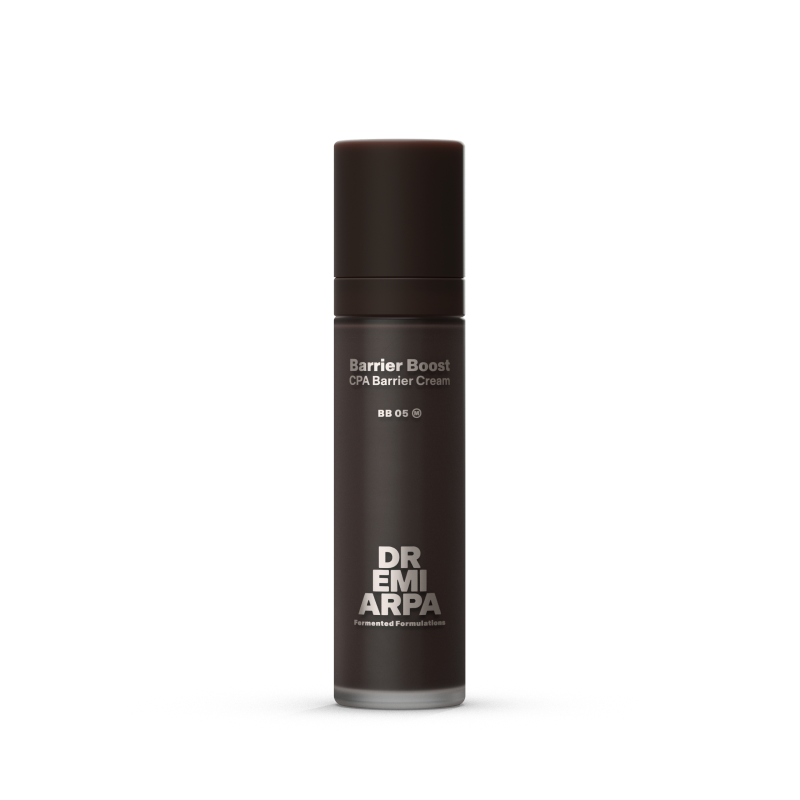
WHAT IS THE SKIN BARRIER AND WHY IS IT SO IMPORTANT?
Share
Why is an intact skin barrier so important for healthy skin and what functions does this invisible shield have? Learn why and how the skin barrier is the focus at DR. EMI ARPA SKIN.
Protective Shield Skin Barrier
Our skin forms a barrier that protects the body from external damage. This includes toxic, solar, and pathogenic influences. Since the skin mantle is the first point of contact with environmental factors, its health and function are essential for the protection of the organism. The barrier function of the skin is supported by four pillars:
1. Microbial barrier as a skin barrier function
The microbial barrier consists of certain microorganisms such as bacteria, fungi, and yeasts. The entirety of the permanent 'good' microorganisms is also called commensals. One main function of the microbial barrier is that the 'good' organisms should take away the space from the 'bad' ones. There is only a limited amount of space or nutrients on the skin, for which the microbes compete. If there is a loss of 'good' microbes in one place, it provides a habitat for pests. These can cause inflammations, chronic wounds, or abscesses.
In addition, the microbial barrier is formed by the excretions of 'good' microorganisms. This includes, for example, antibiotic substances that have a potent effect against one of the main pathogens of the skin (Staphylococcus aureus).
2. Physical barrier as skin barrier function
The physical barrier is mainly formed by horn-producing cells called keratinocytes. They go through their journey starting from the formation from epidermal stem cells until they shed at the skin surface. The cycle takes about four weeks in a healthy skin condition. The keratinocytes can be simply imagined as the bricks of a wall. The mortar is represented by filaments and lipids (including sphingolipids), which close the gaps and form a finished wall as a symbol of the physical barrier. The presence of epidermal stem cells also ensures rapid regeneration or (wound) healing in superficial skin injuries.
3. Chemical Barrier as Skin Barrier Function
The main function of the chemical barrier is to maintain an acidic environment, because the acidic pH value can prevent bacterial colonization by pathogens. The acidic environment is formed by lipolytic enzymes, which hydrolyze free fatty acids from triglycerides in sebum. This means a win-win situation for the skin arises: On the one hand, the free fatty acids nourish the 'good' bacteria, while on the other hand, they fight the 'bad' bacteria.
4. Immunological barrier as a skin barrier function
The immunological barrier is based on many complex interactions between immune cells. Furthermore, antibiotic and antiviral substances are excreted, which support the defense against pathogens. In addition, Langerhans cells come into play. These are inactive dendritic cells in the stratum spinosum, the thickest layer of the epidermis, which serve for antigen presentation. The Langerhans cells alert the immune system upon contact with pathogens and sit like a kind of sentinel in the epidermis.
Skin health thanks to an intact skin barrier
A healthy skin barrier is therefore based on numerous processes and structures. A large part of the whole is formed by the skin microbiome, which can control and direct all other pillars of the skin barrier. If there are disruptions in one of the pillars, a point of attack for all kinds of skin diseases is provided. Therefore, protecting the skin barrier should be a central thought in (every) skincare and daily skincare routine.
SOURCES
Almoughrabie S, Cau L, Cavagnero K, O'Neill AM, Li F, Roso-Mares A, et al. Commensal Cutibacterium acnes induce epidermal lipid synthesis important for skin barrier function. Sci Adv. 2023;9(33):6262.
Harris-Tryon TA, Grice EA. Microbiota and maintenance of skin barrier function. Science. 2022;376(6596):940-5.
Uberoi A, Bartow-McKenney C, Zheng Q, Flowers L, Campbell A, Knight SAB, et al. Commensal microbiota regulates skin barrier function and repair via signaling through the aryl hydrocarbon receptor. Cell Host Microbe. 2021;29(8):1235-48.
Tomic-Canic M, Burgess JL, O'Neill KE, Strbo N, Pastar I. Skin Microbiota and its Interplay with Wound Healing. Am J Clin Dermatol. 2020;21(Suppl 1):36-43
IMAGE MATERIAL/PHOTO/VIDEO



